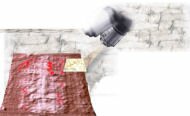
SHROUD SCIENCE GROUP INTERNATIONAL CONFERENCE
The Shroud of Turin: Perspectives on a Multifaceted Enigma
OHIO STATE UNIVERSITY BLACKWELL HOTEL
August 14 through August 17, 2008 Abstracts of Papers
Resolution of Images Obtained Without an Acquisition System Using MTF
by Giulio Fanti ( ) and Roberto Basso (). Friday, August 15, 4:23 p.m.–4:45 p.m.
This paper proposes an extension of the traditional evaluation of the modulation transfer function (MTF) curves made in photography. Normally the analysis is made knowing subject, acquisition system, and output image, but in this paper the same approach has been used also in the case in which the acquisition system is not well-defined. In addition the analysis has been extended in the case when the input is not well-known, if a relatively low quality of the result is accepted. This last approach has been applied to the Turin Shroud (TS) image and to other images to determine the corresponding resolution.
 The method is at first applied when only the acquisition system is not well-defined as in the case of images of objects obtained from fabrics exposed to gas diffusion. Then the method is applied when the input is also not well- known as it is in the case of the TS. In such case both the TS face and hands have been analyzed and the input image was defined as the means of these body parts photographed using similar subjects. In this case the face and the right hand of the TS are studied underlining the relatively high resolution of such images in comparison with other examples.
The method is at first applied when only the acquisition system is not well-defined as in the case of images of objects obtained from fabrics exposed to gas diffusion. Then the method is applied when the input is also not well- known as it is in the case of the TS. In such case both the TS face and hands have been analyzed and the input image was defined as the means of these body parts photographed using similar subjects. In this case the face and the right hand of the TS are studied underlining the relatively high resolution of such images in comparison with other examples.
In the first case of a photograph taken into consideration, the MTF curve of an image (obtained by R. Rogers), produced by chemical reaction of gas emitted by ropes, shows that the corresponding resolution at the 5 percent of  the MTF is 9±3 mm. In the case of the TS the resolution of the images reaches 4,9±0,5 mm at the 5 percent MTF value confirming the results of previous studies (those of J. Jackson for example) made in a more subjective way. The method was also applied to examples of images obtained by gas discharge visualization (GDV) that are generated using coronal discharge.
the MTF is 9±3 mm. In the case of the TS the resolution of the images reaches 4,9±0,5 mm at the 5 percent MTF value confirming the results of previous studies (those of J. Jackson for example) made in a more subjective way. The method was also applied to examples of images obtained by gas discharge visualization (GDV) that are generated using coronal discharge.
A process analogous to GDV is supposed by many researchers to be responsible for the TS body image. As the resulting resolution of GDV images of 5,3±0,3 mm is compatible with that of the Shroud images, this results is a further confirmation of the possibility that the coronal discharge process was involved in the TS image formation.
From the comparison of the MTF curves relative to the TS images with those typical of optical systems, it results in an anomaly at the low spatial frequencies that clearly presents values less than the unity in the MTF plot. The evident peak at spatial frequencies of about 30 m-1 in the TS images corresponds to spots of about 33 mm. If verified with future studies, this data would set a new interesting characteristic of the TS image: the “acquisition system” should be characterized by the fact that spatial frequencies around 30 m-1 are better represented than the others and therefore the “acquisition system” generated spots of the order of 33 mm. This could be a help for the understanding of the body image formation mechanism.
These results, in reference to the studies on the possible formation mechanism of the Shroud image not yet completely known to the science, are in favour of a radiative phenomenon coming from the inside of the body wound in the TS; they are contrary to the diffusive hypothesis as a principal cause of image formation, and they open a new possibility of comparison with the GDV technique.
These results are also discussed in terms of smooth surface effects, object-sheet distance effects, resolution of small areas, such as those obtained by means of CD experiments, and those where coins are supposed to be on the TS.
Content Hosted by Innoval Systems Solutions, Inc & Shroud Story